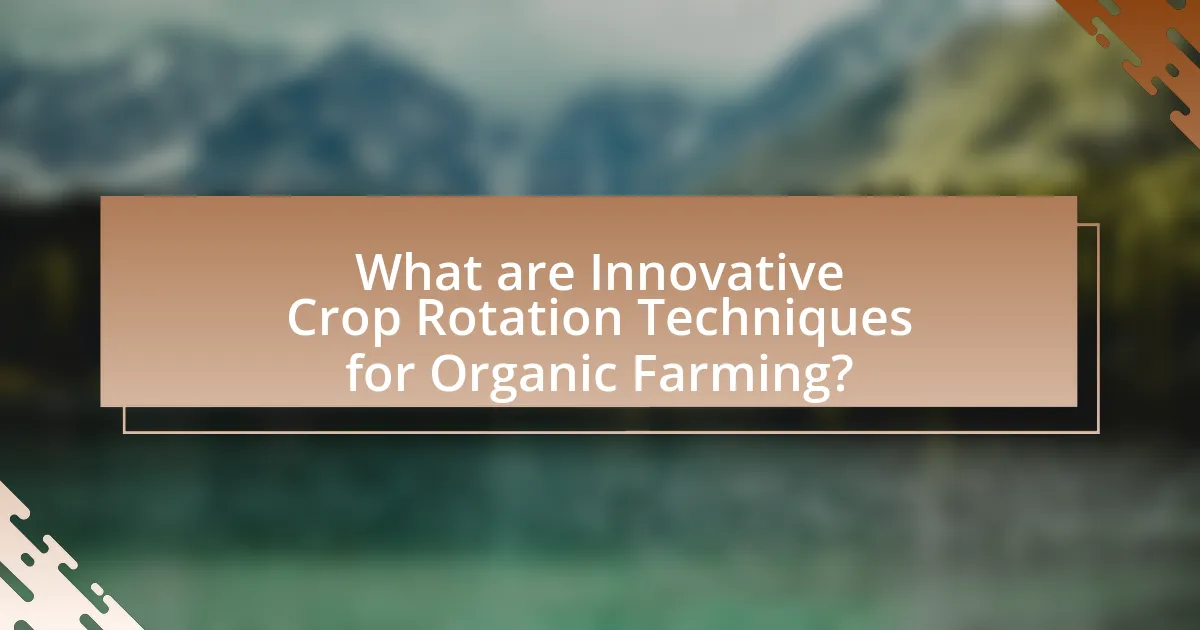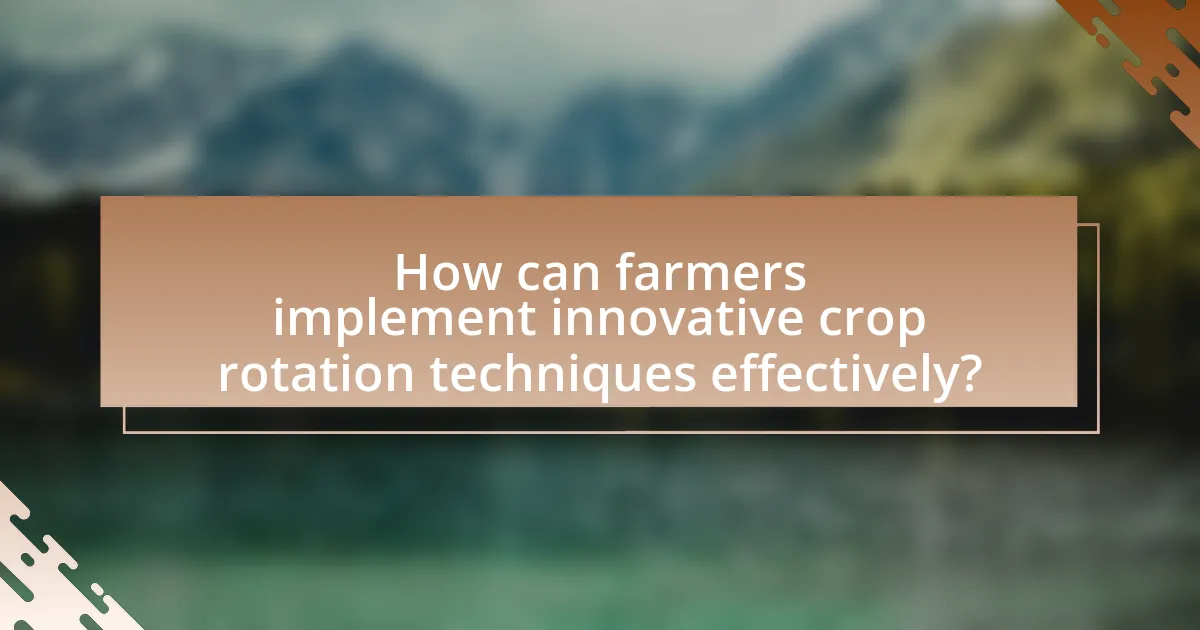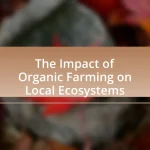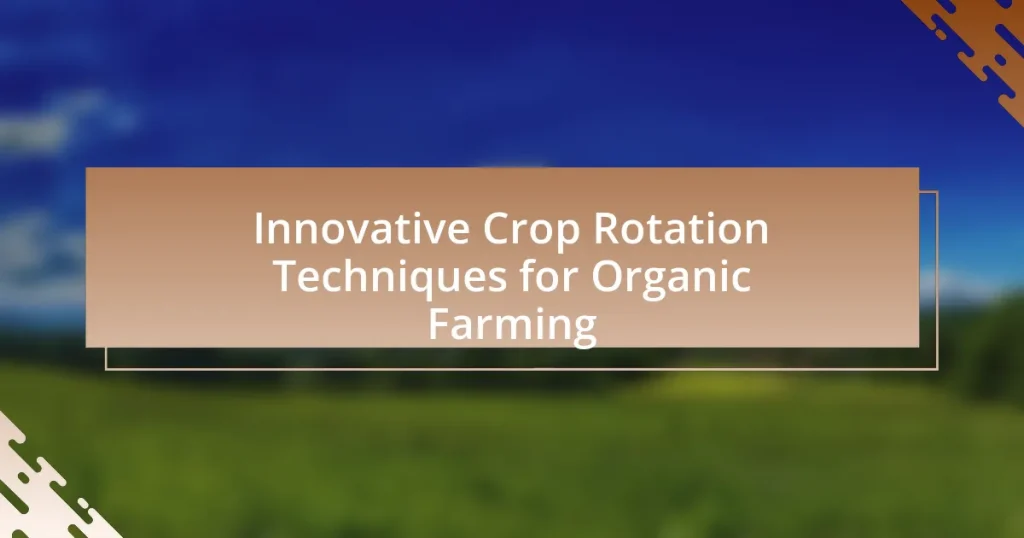Innovative crop rotation techniques for organic farming focus on enhancing soil health, managing pests, and optimizing nutrient use through practices such as cover cropping, intercropping, and diverse crop sequences. These methods differ from traditional crop rotation by emphasizing biodiversity and ecological balance, leading to improved yields and reduced reliance on synthetic inputs. Key principles include alternating deep-rooted and shallow-rooted crops, integrating legumes for nitrogen fixation, and utilizing diverse crop combinations to disrupt pest cycles. Research supports that these innovative techniques can significantly increase soil organic matter, enhance biodiversity, and improve overall farm productivity, making them essential for sustainable agricultural practices.

What are Innovative Crop Rotation Techniques for Organic Farming?
Innovative crop rotation techniques for organic farming include the use of cover crops, intercropping, and diverse crop sequences. Cover crops, such as legumes, enhance soil fertility by fixing nitrogen, while intercropping, which involves growing two or more crops in proximity, can improve pest management and resource utilization. Diverse crop sequences help break pest and disease cycles, leading to healthier crops and improved yields. Research indicates that these techniques can increase soil organic matter and biodiversity, contributing to sustainable agricultural practices. For instance, a study published in the journal “Agronomy for Sustainable Development” found that diverse crop rotations significantly improved soil health and crop productivity in organic systems.
How do these techniques differ from traditional crop rotation methods?
Innovative crop rotation techniques differ from traditional methods primarily in their focus on biodiversity and ecological balance. While traditional crop rotation typically involves alternating crops in a fixed sequence to manage soil fertility and pest control, innovative techniques emphasize integrating cover crops, intercropping, and agroecological principles to enhance soil health and ecosystem services. For instance, innovative methods may incorporate legumes to fix nitrogen and improve soil structure, whereas traditional methods might rely solely on crop diversity without such ecological interactions. This shift towards a more holistic approach is supported by research indicating that diverse cropping systems can lead to improved resilience against pests and diseases, as well as increased yields over time.
What are the key principles behind innovative crop rotation?
The key principles behind innovative crop rotation include enhancing soil health, managing pests and diseases, and optimizing nutrient use. Enhancing soil health is achieved by alternating deep-rooted and shallow-rooted crops, which improves soil structure and fertility. Managing pests and diseases is facilitated by rotating crops that disrupt pest life cycles, reducing the need for chemical interventions. Optimizing nutrient use involves planting legumes that fix nitrogen, thereby enriching the soil for subsequent crops. These principles are supported by research indicating that diverse crop rotations can lead to increased yields and reduced input costs, as demonstrated in studies published by the American Society of Agronomy.
How do these techniques enhance soil health?
Innovative crop rotation techniques enhance soil health by improving nutrient availability, increasing soil organic matter, and promoting biodiversity. These techniques, such as alternating deep-rooted and shallow-rooted crops, help to optimize nutrient uptake and reduce soil depletion. For instance, legumes in rotation fix atmospheric nitrogen, enriching the soil and reducing the need for synthetic fertilizers. Additionally, diverse crop rotations can disrupt pest and disease cycles, leading to healthier soil ecosystems. Research indicates that farms employing diverse crop rotations can see a 20-30% increase in soil organic matter over time, which is crucial for soil structure and fertility.
Why is crop rotation important in organic farming?
Crop rotation is important in organic farming because it enhances soil health, reduces pest and disease pressure, and improves crop yields. By alternating different crops in a specific sequence, organic farmers can prevent nutrient depletion, as different plants have varying nutrient requirements and contributions to the soil. Research indicates that crop rotation can lead to a 10-20% increase in crop yields compared to monoculture systems, as it promotes biodiversity and soil structure. Additionally, rotating crops disrupts the life cycles of pests and diseases, reducing the need for chemical interventions, which aligns with organic farming principles.
What benefits does crop rotation provide for pest management?
Crop rotation provides significant benefits for pest management by disrupting the life cycles of pests and reducing their populations. When different crops are planted in succession, it creates an unfavorable environment for pests that thrive on specific plants, thereby minimizing their chances of survival and reproduction. For instance, rotating crops can break the cycle of pests like rootworms and aphids, which are often crop-specific. Research indicates that crop rotation can lead to a reduction in pest populations by up to 50%, as demonstrated in studies conducted by the University of Illinois, which found that diverse cropping systems significantly lower pest incidence compared to monoculture practices.
How does crop rotation contribute to biodiversity?
Crop rotation contributes to biodiversity by promoting a diverse range of plant species and enhancing soil health. This agricultural practice reduces the prevalence of pests and diseases associated with monoculture, as different crops can disrupt pest life cycles and improve ecosystem resilience. Research indicates that fields with diverse crop rotations support a wider variety of beneficial organisms, such as pollinators and soil microbes, which are essential for maintaining ecological balance. For example, a study published in the journal “Agriculture, Ecosystems & Environment” found that diverse crop rotations increased the abundance of beneficial insects by up to 50%, demonstrating the positive impact of this technique on biodiversity.

What are the different types of innovative crop rotation techniques?
Innovative crop rotation techniques include cover cropping, intercropping, and sequential cropping. Cover cropping involves planting specific crops, such as legumes, to improve soil health and fertility while preventing erosion. Intercropping refers to growing two or more crops in proximity to enhance biodiversity and optimize resource use, which can lead to increased yields. Sequential cropping involves planting different crops in succession within the same growing season, maximizing land use and reducing pest cycles. These techniques have been shown to improve soil structure, enhance nutrient cycling, and increase overall farm productivity, as evidenced by studies demonstrating higher yields and reduced input costs in organic farming systems.
How can cover cropping be integrated into crop rotation?
Cover cropping can be integrated into crop rotation by alternating cash crops with cover crops during fallow periods or after harvest. This practice enhances soil health, improves nutrient cycling, and reduces erosion. For instance, planting legumes as cover crops can fix nitrogen in the soil, benefiting subsequent crops. Research indicates that integrating cover crops into rotation can lead to a 10-30% increase in crop yields due to improved soil structure and fertility.
What are the benefits of using cover crops in organic farming?
Cover crops in organic farming provide numerous benefits, including improved soil health, enhanced nutrient cycling, and reduced erosion. These crops, such as clover and rye, contribute organic matter to the soil, which increases microbial activity and nutrient availability. Research indicates that cover crops can reduce nitrogen leaching by up to 50%, thereby improving water quality and reducing the need for synthetic fertilizers. Additionally, they suppress weeds and pests, leading to lower reliance on chemical inputs, which aligns with organic farming principles.
How do cover crops improve soil structure and fertility?
Cover crops improve soil structure and fertility by enhancing soil aggregation and increasing nutrient availability. The roots of cover crops create channels in the soil, which improves aeration and water infiltration, leading to better root growth for subsequent crops. Additionally, cover crops contribute organic matter to the soil as they decompose, which boosts microbial activity and nutrient cycling. Research indicates that using cover crops can increase soil organic carbon levels by 0.1 to 0.5% per year, significantly enhancing soil fertility over time.
What role does intercropping play in innovative crop rotation?
Intercropping enhances innovative crop rotation by promoting biodiversity and optimizing resource use. This practice involves growing two or more crops in proximity, which can lead to improved soil health, reduced pest pressure, and increased yields. Research indicates that intercropping can enhance nutrient cycling and reduce the need for synthetic fertilizers, as different crops can utilize nutrients at varying soil depths and rates. For instance, a study published in the journal “Agronomy for Sustainable Development” found that intercropping legumes with cereals increased overall productivity by 20-30% compared to monoculture systems, demonstrating its effectiveness in sustainable agricultural practices.
How does intercropping enhance resource utilization?
Intercropping enhances resource utilization by allowing different plant species to grow together, which optimizes the use of available resources such as light, water, and nutrients. This practice leads to increased biodiversity and improved soil health, as complementary crops can utilize resources at different soil depths and growth stages. For instance, legumes can fix nitrogen in the soil, benefiting neighboring crops that require nitrogen, thus reducing the need for synthetic fertilizers. Studies have shown that intercropping can increase overall yield by 10-30% compared to monoculture systems, demonstrating its effectiveness in maximizing resource efficiency in organic farming.
What are the best crop combinations for intercropping?
The best crop combinations for intercropping include maize and beans, which enhance nitrogen fixation, and tomatoes with basil, which can improve growth and flavor. Research indicates that intercropping maize with beans can increase overall yield by up to 20% due to complementary growth patterns and resource utilization. Additionally, the combination of tomatoes and basil has been shown to repel pests and enhance the growth of both plants, leading to better productivity. These combinations leverage the benefits of biodiversity, optimize space, and improve soil health, making them effective strategies in organic farming practices.

How can farmers implement innovative crop rotation techniques effectively?
Farmers can implement innovative crop rotation techniques effectively by planning diverse crop sequences that enhance soil health and reduce pest pressures. This involves selecting crops that complement each other, such as alternating deep-rooted and shallow-rooted plants, which can improve nutrient uptake and soil structure. Research indicates that rotating legumes with cereals can increase nitrogen availability in the soil, promoting better growth and yield. Additionally, farmers should monitor soil health and pest populations to adjust their rotation plans based on specific local conditions, ensuring that the chosen crops provide maximum benefits.
What are the steps to designing a crop rotation plan?
The steps to designing a crop rotation plan include assessing soil health, selecting appropriate crops, planning the sequence of planting, and monitoring the results. First, assessing soil health involves testing for nutrient levels and pH to determine the best crops for the specific soil conditions. Next, selecting appropriate crops should consider factors such as nutrient requirements, pest resistance, and growth cycles to ensure compatibility and sustainability. The planning of the sequence of planting should aim to alternate deep-rooted and shallow-rooted crops to optimize nutrient uptake and minimize soil erosion. Finally, monitoring the results involves evaluating crop yields and soil health over time to adjust the rotation plan as necessary for continuous improvement. These steps are essential for maximizing productivity and maintaining ecological balance in organic farming systems.
How can farmers assess their specific soil and crop needs?
Farmers can assess their specific soil and crop needs by conducting soil tests and analyzing crop performance data. Soil tests provide essential information about nutrient levels, pH, and organic matter content, enabling farmers to tailor their fertilization and amendment strategies. For instance, a study by the University of California found that soil testing can increase crop yields by up to 20% by ensuring that nutrient applications meet the specific needs of the soil. Additionally, monitoring crop performance through yield data and visual assessments helps farmers understand which crops thrive in their specific soil conditions, allowing for informed decisions on crop rotation and management practices.
What tools and resources are available for planning crop rotations?
Tools and resources available for planning crop rotations include software applications, online databases, and agricultural extension services. Software like Crop Rotation Planner and Agri-Data helps farmers design effective crop rotation schedules based on soil health, pest management, and nutrient needs. Online databases, such as the USDA’s National Agricultural Library, provide access to research articles and guidelines on crop rotation practices. Additionally, agricultural extension services offer expert advice and resources tailored to local conditions, helping farmers implement successful crop rotation strategies. These tools and resources are essential for optimizing crop yields and maintaining soil fertility in organic farming.
What challenges might farmers face when adopting these techniques?
Farmers may face several challenges when adopting innovative crop rotation techniques for organic farming, including knowledge gaps, initial costs, and potential yield variability. Knowledge gaps arise as farmers may lack the necessary training or understanding of new methods, which can hinder effective implementation. Initial costs can be significant, as transitioning to new techniques often requires investment in new seeds, equipment, or soil amendments. Additionally, yield variability can occur during the transition period, as farmers may experience fluctuations in crop performance while adapting to new practices. These challenges can impede the successful adoption of innovative crop rotation techniques in organic farming.
How can farmers overcome resistance to change in farming practices?
Farmers can overcome resistance to change in farming practices by implementing education and demonstration programs that showcase the benefits of innovative techniques. Research indicates that hands-on workshops and field days can effectively illustrate the advantages of new practices, such as improved soil health and increased yields. For instance, a study by the University of California found that farmers who participated in demonstration plots were 30% more likely to adopt new crop rotation techniques compared to those who did not engage in such programs. By providing tangible evidence of success and fostering a community of support, farmers can reduce skepticism and encourage the adoption of innovative practices.
What are common misconceptions about crop rotation in organic farming?
Common misconceptions about crop rotation in organic farming include the belief that it is only necessary for pest control and that it requires a complex schedule. In reality, crop rotation serves multiple purposes, including improving soil health, enhancing nutrient availability, and reducing disease incidence. Additionally, while some farmers think that a rigid rotation plan is essential, flexible and adaptive approaches can be equally effective, allowing for adjustments based on specific conditions and crop needs. Research indicates that diverse crop rotations can lead to increased yields and reduced reliance on synthetic inputs, demonstrating the multifaceted benefits of this practice in organic farming.
What best practices should be followed for successful crop rotation?
Successful crop rotation requires diversifying crops, maintaining soil health, and planning planting schedules. Diversifying crops helps break pest and disease cycles, as different plants attract different pests and have varying nutrient needs. Maintaining soil health involves rotating deep-rooted and shallow-rooted plants to enhance soil structure and nutrient availability. Planning planting schedules ensures that crops are rotated in a timely manner, allowing for optimal growth conditions and minimizing competition for resources. Research indicates that implementing these practices can lead to increased yields and improved soil fertility over time.
How can farmers monitor and evaluate the effectiveness of their crop rotation?
Farmers can monitor and evaluate the effectiveness of their crop rotation by analyzing soil health, crop yield data, and pest and disease incidence. Soil health can be assessed through regular soil testing, which measures nutrient levels, pH, and microbial activity, providing insights into the impact of different crops on soil fertility. Crop yield data, collected during harvest, allows farmers to compare the productivity of rotated crops against previous seasons, indicating the success of the rotation strategy. Additionally, tracking pest and disease occurrences helps farmers understand how crop diversity influences pest dynamics, as certain rotations can reduce pest populations and improve overall crop resilience. These methods collectively provide a comprehensive evaluation of crop rotation effectiveness, supported by agronomic research that highlights the benefits of diverse cropping systems in enhancing soil health and productivity.
What tips can enhance the success of innovative crop rotation techniques?
Implementing diverse crop rotations enhances the success of innovative crop rotation techniques. Diverse rotations improve soil health, reduce pest and disease pressure, and optimize nutrient use. For example, rotating legumes with cereals can enhance nitrogen availability in the soil, leading to better crop yields. Additionally, incorporating cover crops during off-seasons can prevent soil erosion and improve organic matter content. Research indicates that farms utilizing diverse crop rotations can see yield increases of 10-20% compared to monoculture systems, demonstrating the effectiveness of these practices in organic farming.










